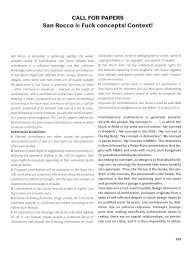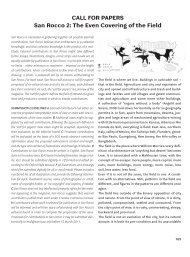CALL FOR PAPERS San Rocco 5: Scary Architects
CALL FOR PAPERS San Rocco 5: Scary Architects
CALL FOR PAPERS San Rocco 5: Scary Architects
Create successful ePaper yourself
Turn your PDF publications into a flip-book with our unique Google optimized e-Paper software.
kings, tyrants and dictators because they are the only<br />
politicians who think about buildings and infrastructure<br />
for the long haul, and not just in megalomaniac/<br />
monumental terms, but also more reasonably in terms<br />
of the fortune they leave to their heirs; indeed, kings invest<br />
in palaces because their sons will inherit them. It<br />
is the time-horizon of dictators, not dictatorship itself,<br />
that is sympathetic to architecture.<br />
Despite all recent attempts to reduce the lifespan of architecture<br />
and dream up buildings that could easily disappear<br />
(from Futurism on), architecture still disturbs<br />
the perfect flatness of contemporaneity, suggesting<br />
a longer span of time. And maybe this is what is really<br />
scary about architecture: a longer time-horizon unavoidably<br />
ushers a new character onto the stage: death.<br />
Architecture is scary: this is a truth, not a choice. Still,<br />
scariness can also be a choice, a precise desire to scare<br />
(one’s enemies? one’s subjects? one’s allies?). The Parthenon,<br />
for instance, is a machine designed to scare<br />
people. Given the absurd amount of money invested in<br />
its construction (a gigantic potlatch?) and its incredible<br />
precision, the Parthenon’s emergence in the relatively<br />
shabby Athens of the 5th century can be understood<br />
only as a colossal menace. The precision of the Parthenon<br />
is the precision of a weapon of mass destruction.<br />
For all the legends about aliens building the pyramids,<br />
the most likely building to have been built by aliens is<br />
the Parthenon, the scariest object ever constructed on<br />
this planet.<br />
So architecture is scary, and making architecture can<br />
be a reaction to the discovery of how fundamentally<br />
scary architecture is. If architecture is the most tangible<br />
sign of an oppressive architecture of society, design<br />
can be understood as an expression of this original evil.<br />
Guido Canella understood architecture in these terms.<br />
The dedicated desperation of Canella’s architecture is<br />
committed to the exhibition of this primitive oppression.<br />
As much as Canella’s ideological construction is<br />
awkward, and as much as his architecture is repulsive<br />
(and we’re talking about his best period), he had something<br />
there. The offensive ugliness that Canella laboriously<br />
erectedin the 1970s in the barren outskirts of<br />
Milan is not just the consequence of the impoverished<br />
life of the proletariat, for these nightmares are not only<br />
202<br />
modern, and this oppression is not only that of the<br />
working class: it is also the oppression of the bourgeois<br />
architect as well as a deeper, somehow unspeakable<br />
oppression, a universal Unbehagen. Similar nightmares<br />
indeed appear in the work of architects as different as<br />
Ricardo Bofill, Ludwig Hilberseimer, Kiyonori Kikutake,<br />
Hans Poelzig, Paul Rudolph and Carel Weeber.<br />
<strong>San</strong> <strong>Rocco</strong> 5 tries to deal with the horror of architecture.<br />
What should we think of the architects who have decided<br />
to scare the rest of the world deliberately? And what<br />
about buildings that are not just big and uncanny, but<br />
deliberately dark, windowless, gloomy, repulsive, antihuman?<br />
Is scary architecture just a desperate quest for<br />
love? As Black Sabbath would put it, “Happiness I cannot<br />
feel and love to me is so unreal”.




